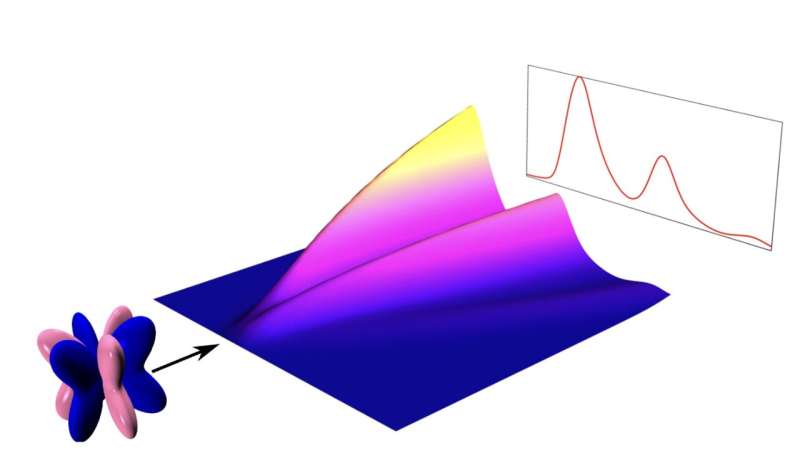Examining Spectroscopic Markers of Fractionalization in Octupolar Quantum Spin Ice

On March 22, 2024, scientists shared their findings on quantum spin liquids, complex quantum systems that have become the focus of recent scientific research. These systems demonstrate a stiff competition between interactions that hampers the creation of a long-range magnetic order, typically seen in conventional magnets where all spins align in one direction, generating a total magnetic field.
Researchers at the University of Toronto unveiled a framework which might simplify the experimental observations of a novel 3D quantum spin liquid, known as π-flux octupolar quantum spin ice (π-O-QSI). In Physical Review Letters, they published their paper highlighting the unique spectroscopic signatures of this system, which could be measurable in upcoming experiments.
Félix Desrochers, a co-author of the paper, elaborated on the peculiarities of quantum spin liquids to Phys.org. Desrochers pointed out that 'these materials showcase fractionalized excitations; the electrons seem to split into several components. However, it is vital to note that these excitations do not result from electrons dividing into many fragments, instead, they are the result of a complex form of collective motion induced by their strong interactions.'
Despite physicists’ active search for explicit instances of the quantum spin liquid state over several decades, the progress has been slow due to a couple of primary reasons. First, creating theoretical models that accurately portray spin liquid ground states and can generate precise predictions has been a challenge.
Desrochers indicated that Quantum spin ice (QSI) is a unique example of a model possessing a well-understood quantum spin liquid ground state that exists in a concrete material (like the family of rare-earth pyrochlores).
In the realm of theoretical predictions, the quantum electrodynamics manifested in QSI differs drastically from conventional electrodynamics. For instance, the 'emergent light' speed should be approximately 1 m/s, opposed to the familiar speed of light at 3x108 m/s.
Exciting results have emerged from recent experiments on Ce2Zr2O7, Ce2Sn2O7, and Ce2Hf2O7. However, recognizing quantum spin liquids is complex due to their fragility. To detect these states without error, specific signatures pertaining to a quantum spin liquid must first be identified.
For their study, Desrochers and his Ph.D. adviser Yong Baek Kim predicted the unique spectroscopic signatures of the π-flux QSI state using the gauge mean-field theory (GMFT) developed by Lucile Savary and Leon Balents in 2012. This theory effectively rewrites initial spin operators to reflect the emergent excitations present in quantum spin ice, namely photons, and spinons.
'This framework was already used to study π-flux QSI in some of the earliest works utilizing GMFT,' Desrochers said. 'We have thus expanded on this work with the aim of making experimentally meaningful predictions. To ensure our predictions are reliable, we have also made extensive comparisons with previous numerical results from our group and the literature.'
This recent study by Desrochers and Kim offers a meaningful prediction of the distinctive spectroscopic signatures of the spin liquid state π-flux QSI. These signatures could guide future experimental studies, helping physicists to confirm the presence of this exotic state.
'We highlighted that π-flux QSI should produce three peaks of decreasing intensity in inelastic neutron scattering,' Desrochers said. 'This is a unique and distinctive signature. If measured, these three peaks would provide compelling evidence for the experimental realization of this three-dimensional QSL.'
Desrochers and Kim hope that their predictions will help researchers to determine what they should expect to measure when encountering the elusive π-flux QSI state. Notably, the spectroscopic signatures they identified should be detectable at currently achievable experimental resolutions, thus they could potentially be observed soon.
Meanwhile, the researchers plan to build on their recent study to gather increasingly detailed predictions. For instance, they would like to study how the peaks they predicted would evolve at different temperatures and estimate at what temperatures they disappear.
'The most exciting future developments will surely come from the experimental side,' Desrochers added. 'Confirmation of the presence of these peaks would offer highly persuasive evidence of the realization of this long-sought-after new state of matter. There are already some encouraging signs: recent work on Ce2Sn2O7 reported measurements that show signs of three peaks of decreasing intensity.'
Journal information: Physical Review Letters , arXiv
© 2024 Science X Network




